Experimental Study and Numerical Simulation of Oscillation Phenomena in a Pressure Swirl Injector
Abstract
1. Introduction
2. Experimental Setup and Numerical Model
2.1. Experimental Setup
2.2. Numerical Model and Grid Independence Validation
3. Results and Discussion
3.1. Experimental Results
3.2. Numerical Results
3.3. Explanations of the Oscillation Phenomenon
4. Conclusions
- The internal flow fields inside the injectors, including velocity, pressure, and the liquid fraction at the interface, change periodically. The velocity and pressure differences between the liquid and gas phases lead to instability of the interface. The behavior of the gas core plays a significant role in the periodic variations of the entire flow field. Under the given conditions, the frequency is about several hundred Hz.
- The diameter of the gas core differs along the axial position inside the pressure swirl injector. The smallest diameter of the gas core exists in the swirl chamber of the injector and increases when approaching the exit of the injector. The oscillation amplitude of the gas core is largest in the central post section.
- As the mass flow rate at the tangential slot increases, the pressure of the gas core decreases, while its velocity rises. This leads to more intense instability, which subsequently results in a higher oscillation frequency within the injector. The fitting formula between the oscillation frequency and Re is f = 4.65 × 10−13 Re3.04.
Author Contributions
Funding
Data Availability Statement
Acknowledgments
Conflicts of Interest
References
- Gan, X.-H. Aero Gas Turbine Engine Fuel Nozzle Technology; National Defense Industry Press: Beijing, China, 2006. (In Chinese) [Google Scholar]
- Zhu, N.-C. Design of Liquid Rocket Engines; Astronautics Press: Beijing, China, 1994. (In Chinese) [Google Scholar]
- Horvay, M.; Leuckel, W. LDA-Measurements of liquid swirl flow in converging swirl chambers with tangential inlets. In Proceedings of the 2nd International Symposium LDA, Lisbon, Portugal, 2–4 July 1985. [Google Scholar]
- Chinn, J.J. The Internal Flow Physics of Swirl Atomizer Nozzles. Ph.D. Thesis, Department of Mechanical Engineering, Thermo-Fluids Division, University of Manchester Institute of Science and Technology, Manchester, UK, October 1996. [Google Scholar]
- Wang, Z.-R. Theoretical analysis of pressure swirl injector operating condition. Propuls. Technol. 1996, 17, 1–8. [Google Scholar]
- Zhou, J.; Hu, X.-P.; Huang, Y.-H.; Wang, Z.-G. An experimental study on acoustic characteristics of gas-liquid coaxial injector of liquid rocket engines. J. Propuls. Technol. 1996, 17, 37–41. (In Chinese) [Google Scholar]
- Huang, Y.-H.; Zhou, J.; Hu, X.-P. Experiment and acoustic model for the self-oscillation of coaxial swirl injector and its influence to combustion of liquid rocket engine. Acta Acust. 1998, 23, 459–465. (In Chinese) [Google Scholar]
- Ma, Z.-H. Investigation on the Internal Flow Characteristics of Pressure-Swirl Atomizer. Ph.D. Thesis, University of Cincinati, Cincinnati, OH, USA, 2001. [Google Scholar]
- Marchione, U.; Allouis, C.; Amoresano, A.; Beretta, F. Experimental investigation of a pressure swirl atomizer spray. J. Propuls. Power 2007, 23, 1096–1101. [Google Scholar] [CrossRef]
- Xue, S.-J.; Liu, H.-J.; Hong, L.; Chen, P.-F. Experiment on self-excited oscillation characteristics of open centrifugal nozzle with thick liquid film. J. Aviat. 2018, 39, 77–86. [Google Scholar]
- Chinn, J.J.; Cooper, D.; Yule, A.J.; Nasr, G.G. Stationary rotary force waves on the liquid-air core interface of a swirl atomizer. Heat Mass Transf. 2015, 52, 2037–2050. [Google Scholar] [CrossRef]
- Maly, M.; Jedelsky, J.; Slama, J.; Janackova, L.; Sapik, M.; Wigley, G.; Jicha, M. Internal flow and air core dynamics in Simplex and Spill-return pressure-swirl atomizers. Int. J. Heat Mass Transf. 2018, 123, 805–814. [Google Scholar] [CrossRef]
- Zhang, X.-Q. Research on Spray Combustion of Multi-Component Fuel Based on Swirl Injector; National University of Defense Technology: Changsha, China, 2016. [Google Scholar]
- Cheng, P.; Li, Q.; Kang, Z.; Chen, H. Response of inner flow and spray characteristics of a pressure swirl injector to pressure oscillation in supply system. Acta Astronaut. 2019, 154, 82–91. [Google Scholar] [CrossRef]
- Vijay, G.A.; Moorthi, N.S.V.; Manivannan, A. Internal and external flow characteristics of swirl atomizers: A review. At. Sprays 2015, 25, 153–188. [Google Scholar] [CrossRef]
- Laurila, E.; Roenby, J.; Maakala, V.; Peltonen, P.; Kahila, H.; Vuorinen, V. Analysis of viscous fluid flow in a pressure-swirl atomizer using large-eddy simulation. Int. J. Multiph. Flow 2019, 113, 371–388. [Google Scholar] [CrossRef]
- Copper, D.; Yule, A.J. Waves on the air core/liquid interface of a pressure swirl atomizer. In Proceedings of the ILASS-Europe, Zürich, Switzerland, 2–6 September 2001. [Google Scholar]
- Maatje, U.; Lavante, E. Numerical simulation of unsteady effects in simplex nozzles. In Proceedings of the 32nd AIAA Fluid Dynamics Conference and Exhibit, St. Louis, MO, USA, 24–26 June 2002. [Google Scholar]
- Vashahi, F.; Lee, J.K. Insight into the Dynamics of Internal and External Flow Fields of the Pressure Swirl Nozzle. At. Sprays 2018, 28, 11. [Google Scholar] [CrossRef]
- Jiang, C.; Ren, Y.; Tong, Y.; Xie, Y.; Chu, W.; Li, X.-Q. Current status and trend of dynamic atomization characteristcis of swirl injector under oscillating environment in liquid rocket engines. J. Natl. Univ. Def. Technol. 2023, 45, 1–19. [Google Scholar]
- Ferrando, D.; Carreres, M.; Belmar-Gil, M.; Cervelló-Sanz, D.; Duret, B.; Reveillon, J.; Salvador, F.J.; Demoulin, F.-X. Modelling internal flow and primary atomization in a simplex pressure-swirl atomizer. At. Sprays 2023, 33, 1–28. [Google Scholar] [CrossRef]
- Liu, J.; Li, Q.-L.; Wang, Z.-G. Flow field in pressure-swirl injector based on VOF interface tracking method and experimental investigation. In Proceedings of the IAC-11-C4.1.16, 62st International Astronautical Congress, Prague, Czech Republic, 3–7 October 2011. [Google Scholar]
- Daniel, L.; Laszlo, F. High-order surface tension VOF-model for 3D bubble flows with high density ratio. J. Comput. Phys. 2004, 200, 153–176. [Google Scholar]
- López, J.; Hernández, J.; Gómez, P.; Faura, F. An improved PLIC-VOF method for tracking thin fluid structures in incompressible two-phase flows. J. Comput. Phys. 2005, 208, 51–74. [Google Scholar] [CrossRef]
- Gopala, V.R.; van Wachem, B.G. Volume of Fluids Methods for Immiscible-fluid and Free-surface Flows. Chem. Eng. J. 2008, 141, 204–221. [Google Scholar] [CrossRef]
- Liu, J.; Zhang, X.-Q.; Li, Q.-L.; Wang, Z.-G. Effect of the geometrical parameters on spray coneangle in a pressure swirl injector. Proc. ImechE Part G J. Aerosp. Eng. 2013, 227, 342–353. [Google Scholar] [CrossRef]



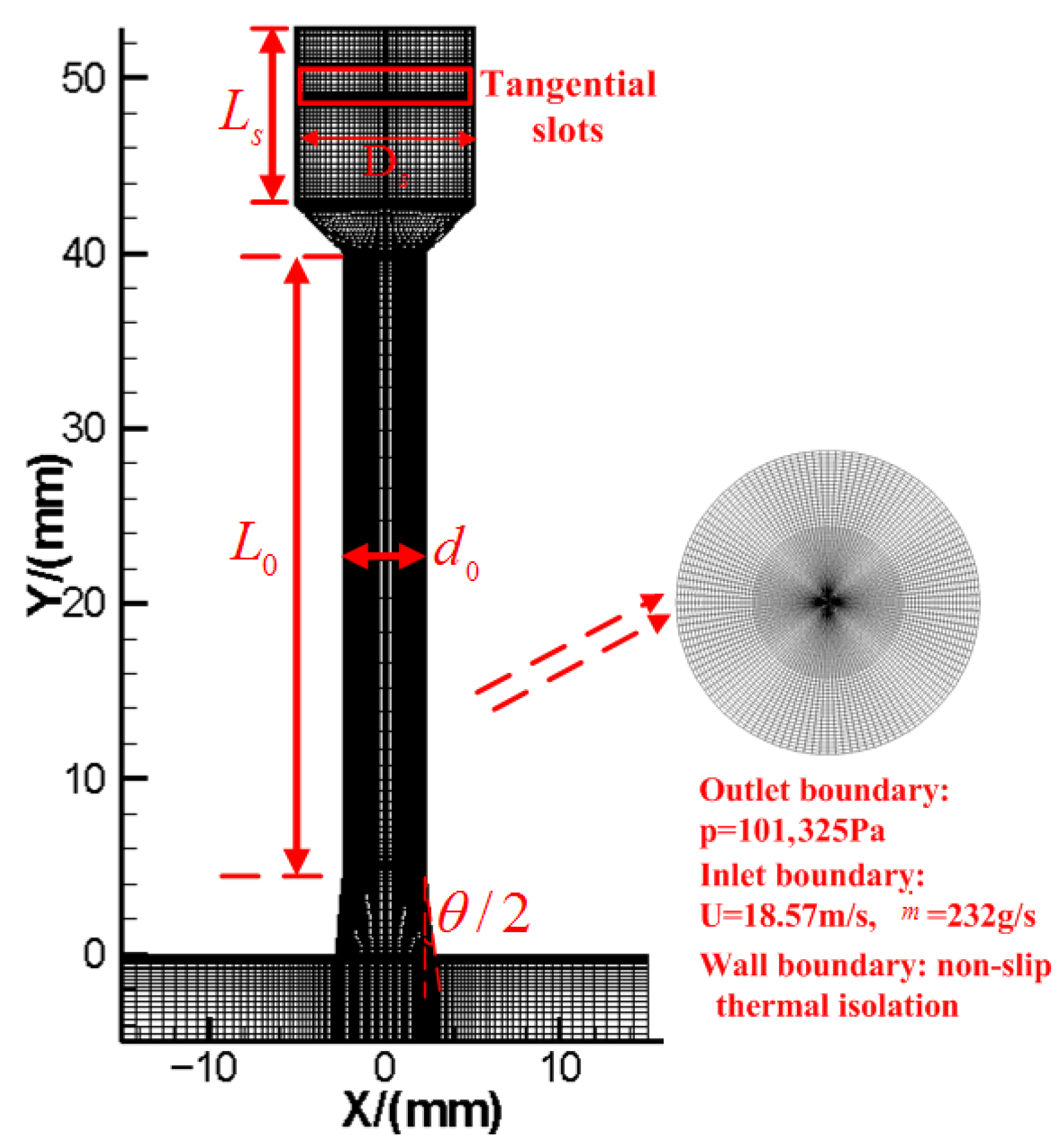
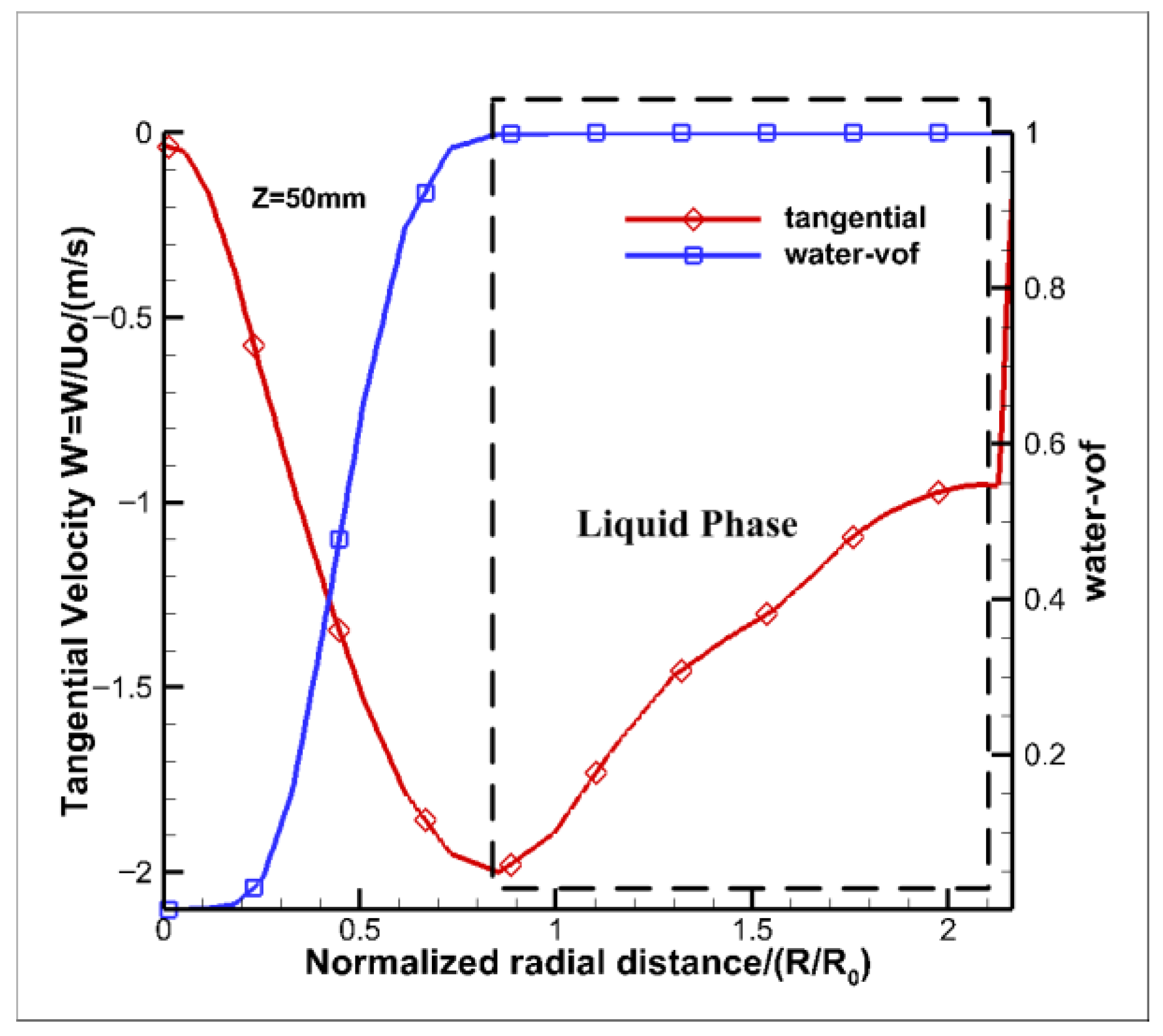

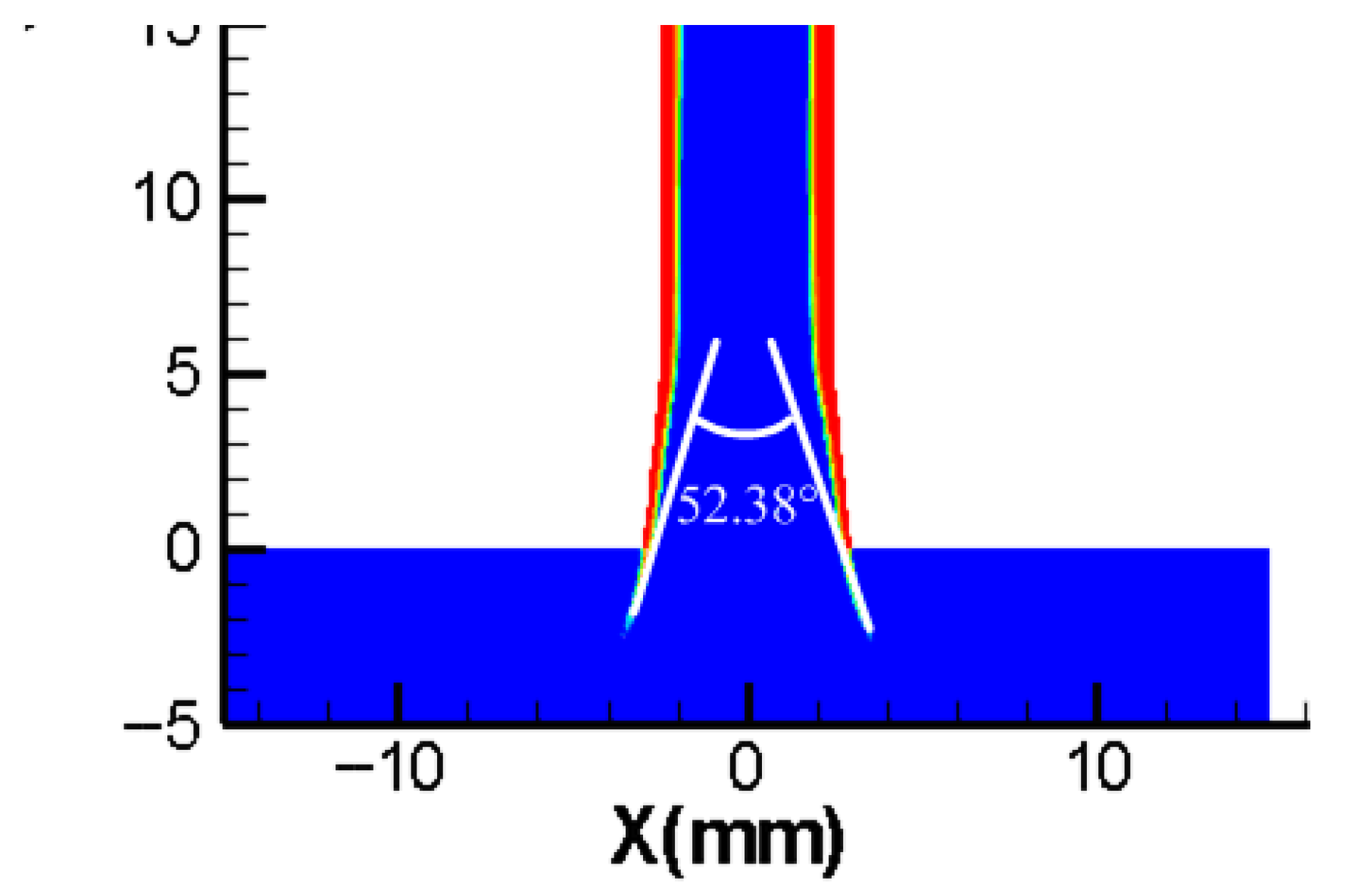

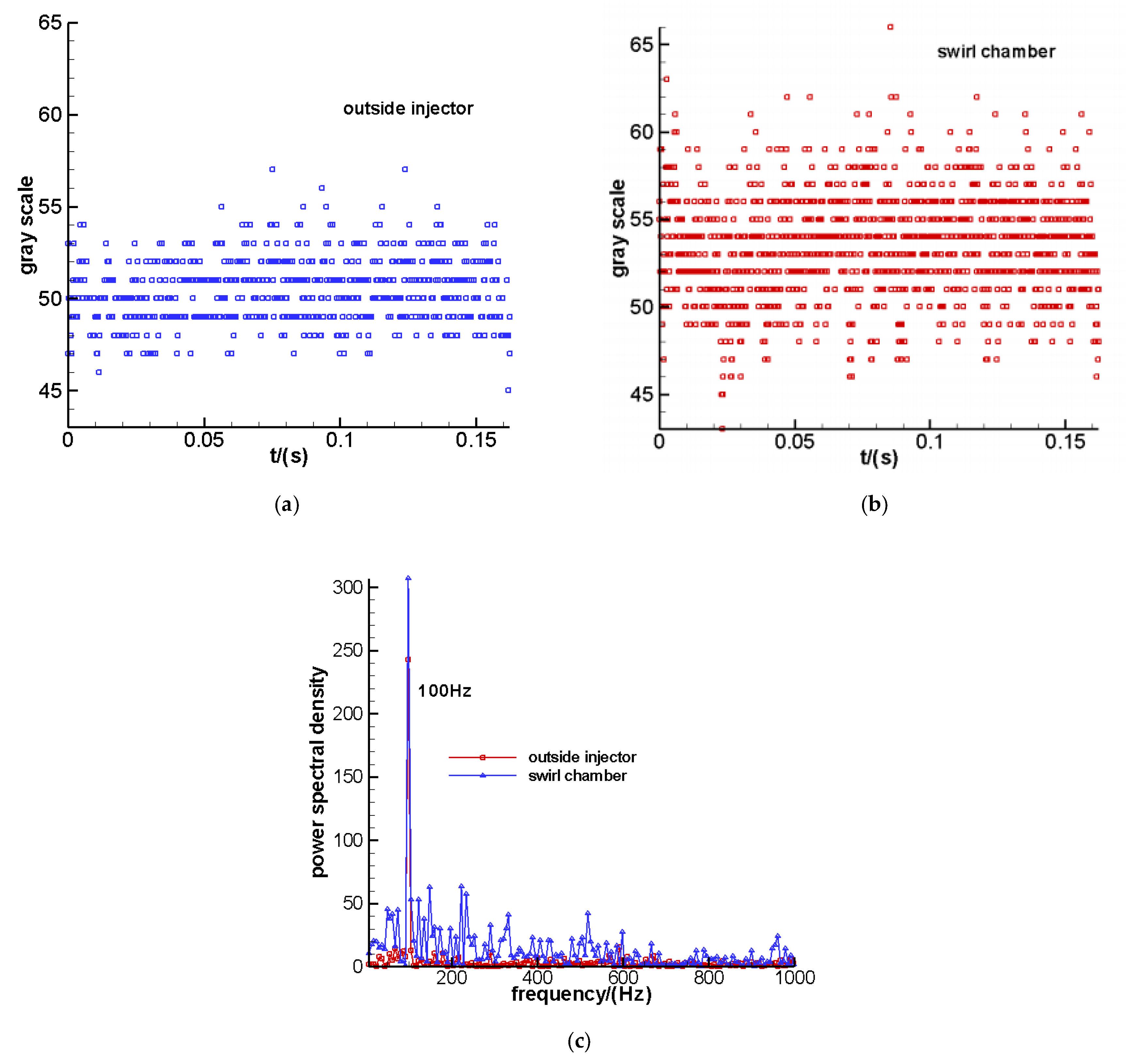




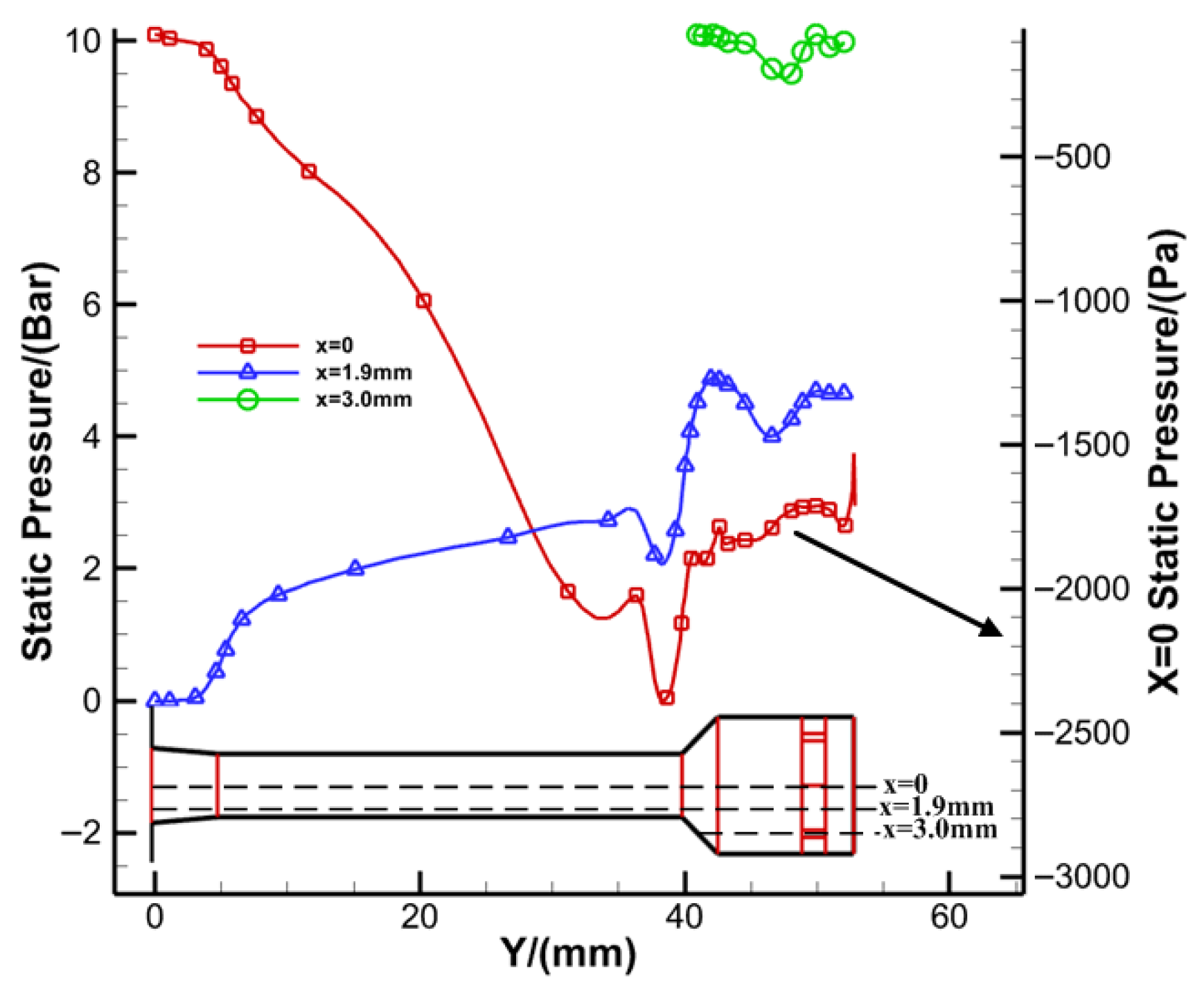

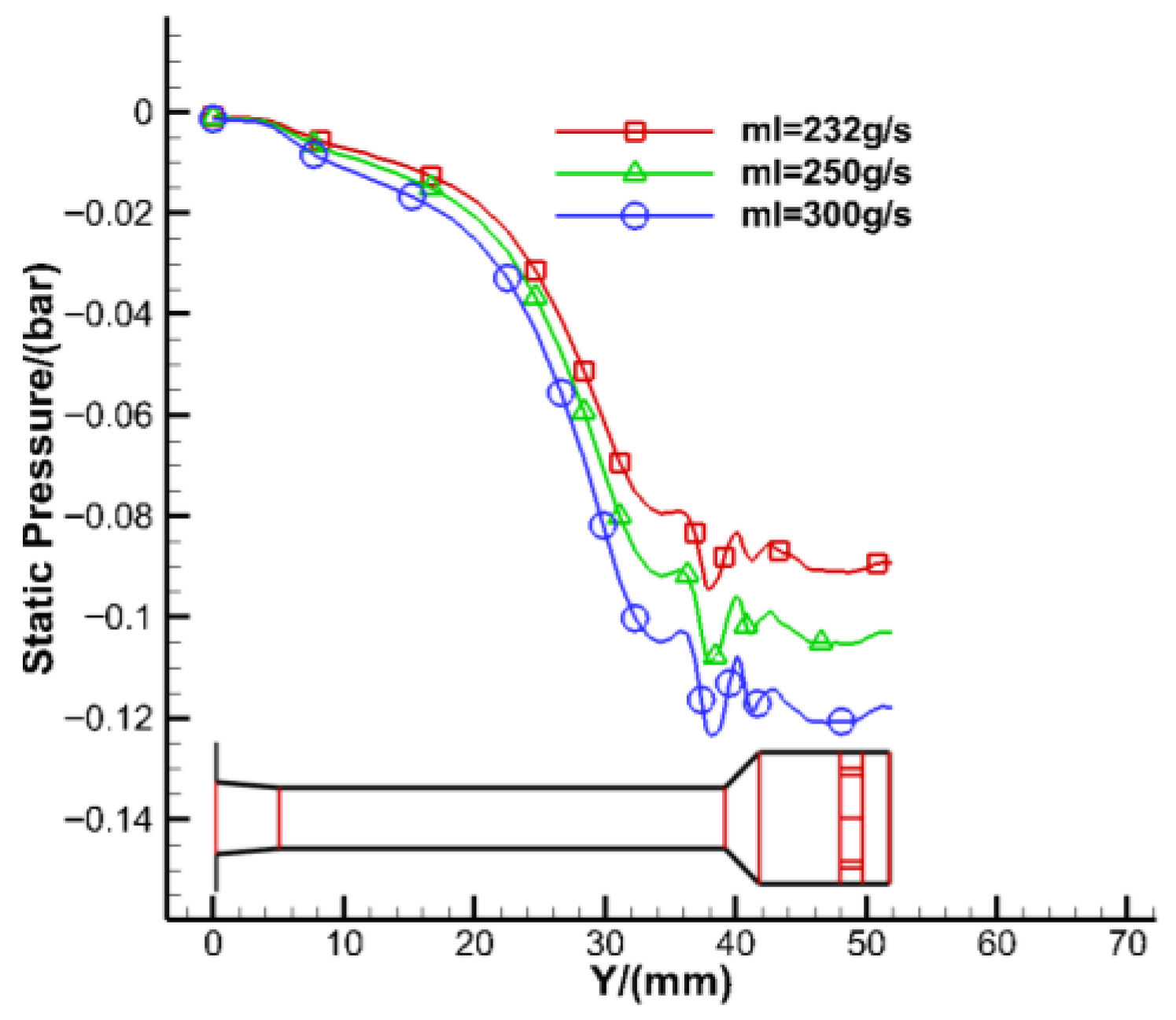
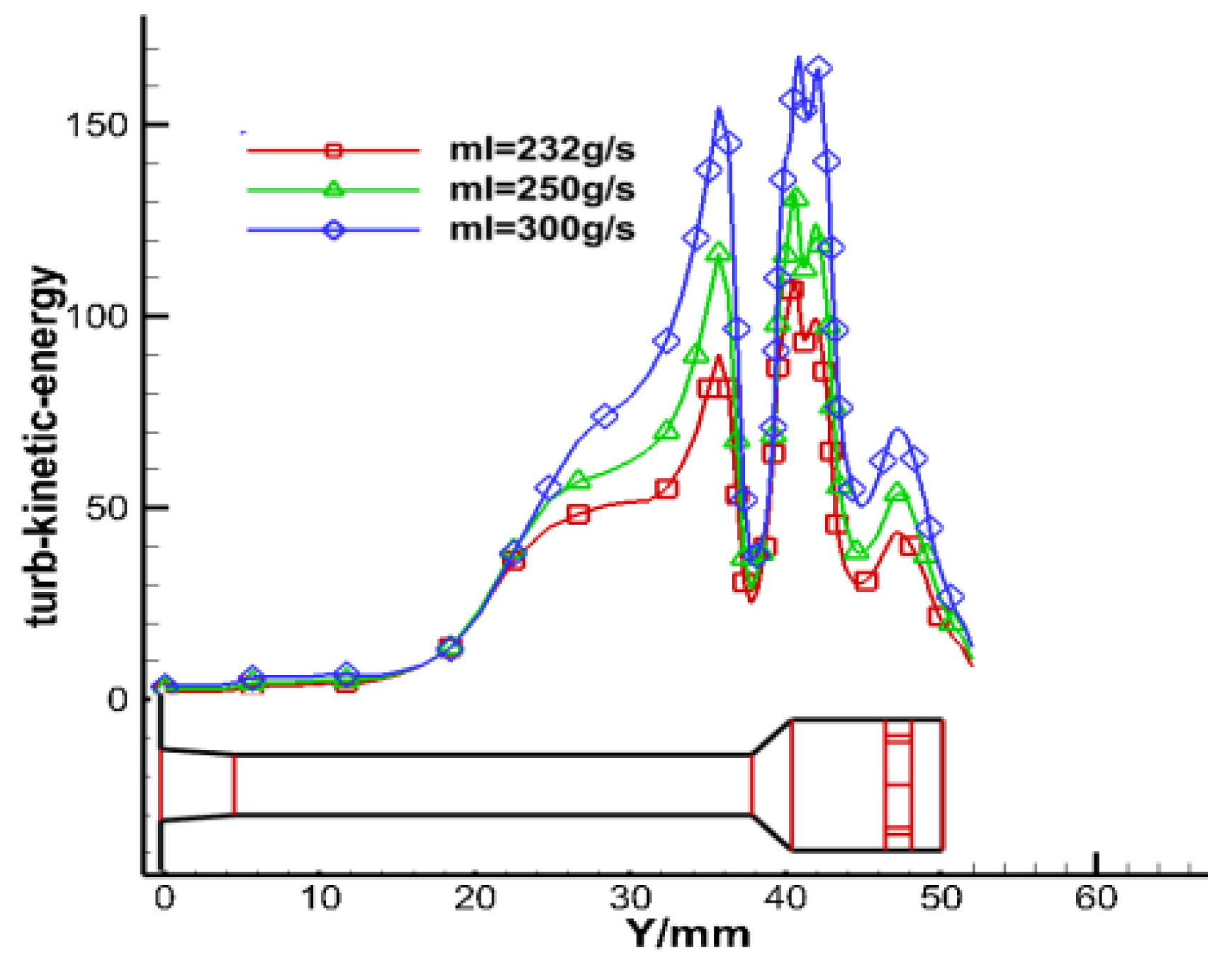


| d0 (mm) | L0 (mm) | Ds (mm) | Ls (mm) | rt (mm) |
|---|---|---|---|---|
| 4.7 | 35 | 10.2 | 10.2 | 1 |
| 108 × 26 × 117 | 128 × 30 × 140 | 156 × 37 × 175 | |
|---|---|---|---|
| Static pressure at the inlet (Pa) | 8.07 × 105 | 8.82 × 105 | 8.78 × 105 |
| Liquid content at grid G | 0.292 | 0.3155 | 0.3160 |
| Y (mm) | * (mm) | * (mm) | * (rad/s) | * (rad) |
|---|---|---|---|---|
| Y = 0 | 2.83 | 0.01493 | 2500 | 39.06 |
| Y = 12 | 1.85 | 0.04304 | 2525 | 45.55 |
| Y = 40 | 1.439 | 0.0336 | 2513 | 38.13 |
| Y = 45 | 1.332 | 0.037 | 2510 | 41.15 |
Disclaimer/Publisher’s Note: The statements, opinions and data contained in all publications are solely those of the individual author(s) and contributor(s) and not of MDPI and/or the editor(s). MDPI and/or the editor(s) disclaim responsibility for any injury to people or property resulting from any ideas, methods, instructions or products referred to in the content. |
© 2025 by the authors. Licensee MDPI, Basel, Switzerland. This article is an open access article distributed under the terms and conditions of the Creative Commons Attribution (CC BY) license (https://creativecommons.org/licenses/by/4.0/).
Share and Cite
Liu, J.; Han, Y. Experimental Study and Numerical Simulation of Oscillation Phenomena in a Pressure Swirl Injector. Aerospace 2025, 12, 1014. https://doi.org/10.3390/aerospace12111014
Liu J, Han Y. Experimental Study and Numerical Simulation of Oscillation Phenomena in a Pressure Swirl Injector. Aerospace. 2025; 12(11):1014. https://doi.org/10.3390/aerospace12111014
Chicago/Turabian StyleLiu, Juan, and Yifan Han. 2025. "Experimental Study and Numerical Simulation of Oscillation Phenomena in a Pressure Swirl Injector" Aerospace 12, no. 11: 1014. https://doi.org/10.3390/aerospace12111014
APA StyleLiu, J., & Han, Y. (2025). Experimental Study and Numerical Simulation of Oscillation Phenomena in a Pressure Swirl Injector. Aerospace, 12(11), 1014. https://doi.org/10.3390/aerospace12111014





